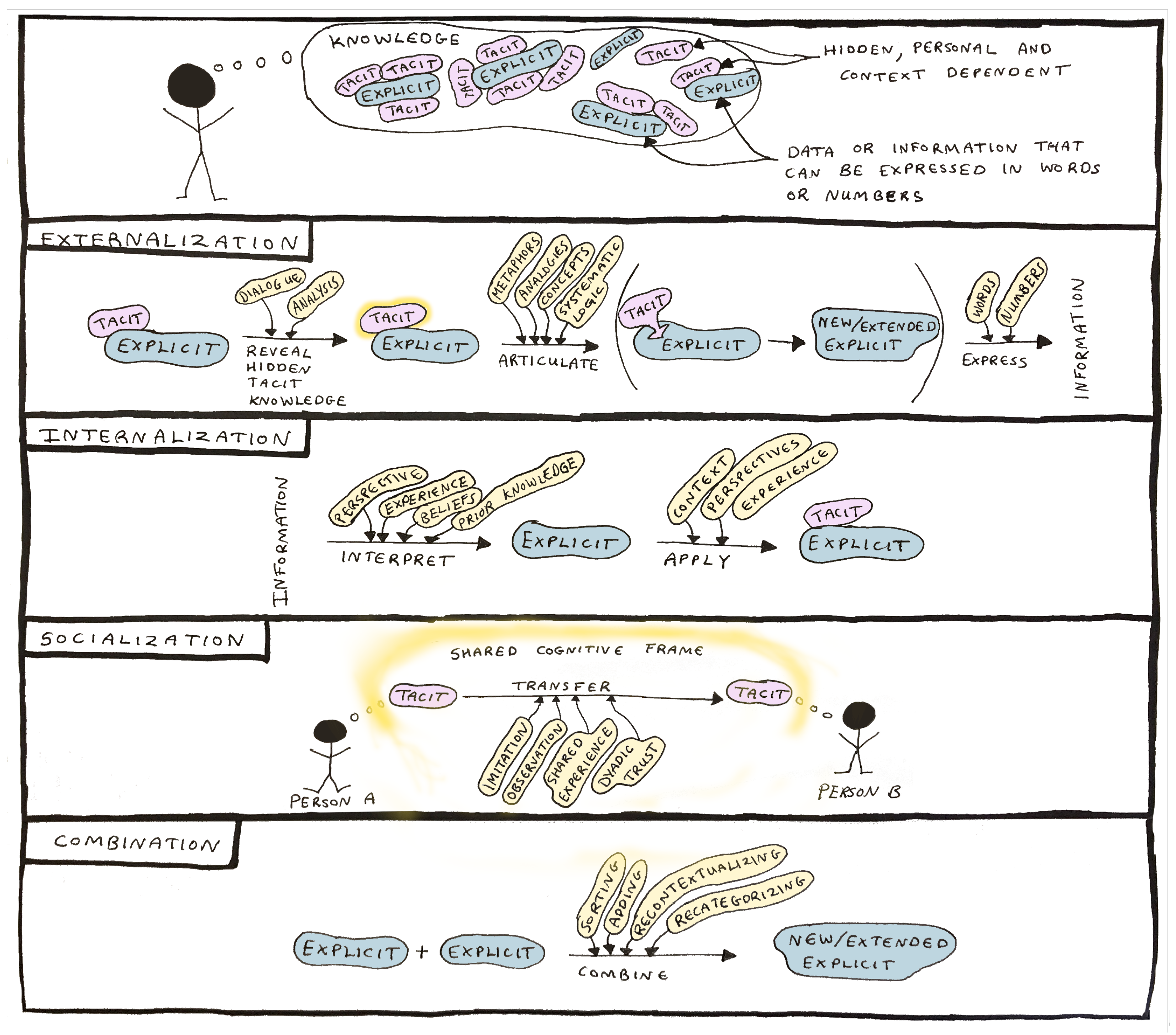A Soft Systems Approach to Knowledge Worker Productivity: A Purposeful Activity Model for the Individual
Abstract
1. Introduction
- They have many viewpoints, which often are competing;
- These viewpoints are not constant, but change with interpretations of new experiences or knowledge of individuals or groups;
- The individuals in the situations behave purposefully rather than from intuition or randomly.
2. Literature Review
2.1. Value in Knowledge Work
2.2. Knowledge
2.3. Personal Resources
2.4. Competencies
- Motives are recurrent thoughts about a goal state or situation that drive an individual to a certain behavior;
- Traits are a characteristic way an individual responds to certain stimuli, that is the consistent responses he/she has to similar situations or information;
- Self-image is an individual’s perception of himself/herself and the interpretation and labeling of that image in the context of values, both his/her own and the values in the environment;
- Social role is an individual’s view of how he/she fits in with regard to the characteristics he/she possesses and the interpreted expectations of others;
- Knowledge is the internalized information an individual has in specific content areas;
- Skill is the individual’s ability to demonstrate specific behavior patterns that are functionally related to attaining a performance goal.
- Cognitive intelligence—competencies that relate to “the ability to think or analyze information and situation” (p. 8), for example systems thinking and pattern recognition competencies;
- Emotional intelligence—competencies that relate to “the ability to recognize, understand and use emotional information about oneself” (p. 8), for example self-awareness and self-management competencies;
- Social intelligence—competencies that relate to “the ability to recognize, understand and use emotional information about others” (p. 8), for example social awareness and relationship management including empathy and teamwork competencies.
3. Purposeful Activity Model of a System for the Individual
3.1. Developing the Purposeful Activity Model
3.2. Purposeful Activity Model
4. Discussions and Conclusions
Author Contributions
Funding
Institutional Review Board Statement
Informed Consent Statement
Data Availability Statement
Conflicts of Interest
Abbreviations
| KW | Knowledge worker |
| KWP | Knowledge Worker productivity |
| SSM | Soft systems methodology |
| IT | Information technology |
| ICT | Information and communication technology |
| KM | Knowledge management |
| KMS | Knowledge management system |
References
- Aboagye, Emmanuel, Christina Björklund, Klas Gustafsson, Jan Hagberg, Gunnar Aronsson, Staffan Marklund, Constanze Leineweber, and Gunnar Bergström. 2019. Exhaustion and impaired work performance in the workplace: Associations with presenteeism and absenteeism. Journal of Occupational and Environmental Medicine 61: e438–44. [Google Scholar] [CrossRef] [PubMed]
- Alimo-Metcalfe, Beverly, John Alban-Metcalfe, Margaret Bradley, Jeevi Mariathasan, and Chiara Samele. 2008. The impact of engaging leadership on performance, attitudes to work and wellbeing at work: A longitudinal study. Journal of Health Organization and Management 22: 586–98. [Google Scholar] [CrossRef] [PubMed]
- Amar, Amar D. 2004. Motivating knowledge workers to innovate: A model integrating motivation dynamics and antecedents. European Journal of Innovation Management 7: 89–101. [Google Scholar] [CrossRef]
- Bogdanowicz, Maureen S., and Elaine K. Bailey. 2002. The value of knowledge and the values of the new knowledge worker: Generation x in the new economy. Journal of European Industrial Training 26: 125–29. [Google Scholar] [CrossRef]
- Borman, Walter C., and Stephan J. Motowidlo. 1997. Task performance and contextual performance: The meaning for personnel selection research. Human Performance 10: 99–109. [Google Scholar] [CrossRef]
- Bowman, Cliff, and Véronique Ambrosini. 2000. Value creation versus value capture: Towards a coherent definition of value in strategy. British Journal of Management 11: 1–15. [Google Scholar] [CrossRef]
- Boyatzis, Richard. 2008. Competencies in the 21st century. Journal of Management Development 27. [Google Scholar] [CrossRef]
- Boyatzis, Richard E. 1982. The Competent Manager. New York: John Wiley and Sons, Inc. [Google Scholar]
- Cake, Martin A., Michelle M. McArthur, Susan M. Matthew, and Caroline F. Mansfield. 2017. Finding the balance: Uncovering resilience in the veterinary literature. Journal of Veterinary Medical Education 44: 95–105. [Google Scholar] [CrossRef] [PubMed]
- Checkland, Peter. 1993. Systems Thinking, Systems Practice. Chichester: John Wiley and Sons Ltd. [Google Scholar]
- Checkland, Peter. 2000. Soft systems methodology: A thirty year retrospective. Systems Research and Behavioral Science 17: 11–58. [Google Scholar] [CrossRef]
- Checkland, Peter. 2011. Autobiographical retrospectives: Learning your way to ‘action to improve’—The development of soft systems thinking and soft systems methodology. International Journal of General Systems 40: 487–512. [Google Scholar] [CrossRef]
- Cooper-Thomas, Helena, and Neil Anderson. 2006. Organizational socialization: A new theoretical model and recommendations for future research and hrm practices in organizations. Journal of Managerial Psychology 21: 492–516. [Google Scholar] [CrossRef]
- Cropanzano, Russell, Deborah Rupp, and Zinta Byrne. 2003. The relationship of emotional exhaustion to job performance ratings and organizational citizenship behavior. The Journal of Applied Psychology 88: 160–69. [Google Scholar] [CrossRef] [PubMed]
- Drucker, Peter F. 1999. Knowledge-worker productivity: The biggest challenge. California Management Review 41: 79–94. [Google Scholar] [CrossRef]
- Drucker, Peter F., Esther Dyson, Charles Handy, Paul Saffo, and Peter M. Senge. 1997. Looking ahead: Implications of the present. Harvard Business Review 75: 18–27. [Google Scholar] [PubMed]
- Ebert, Philip, and Wolfgang Freibichler. 2017. Nudge management: Applying behavioural science to increase knowledge worker productivity. Journal of Organization Design 6: 1–6. [Google Scholar] [CrossRef]
- Edmunds, Angela, and Anne Morris. 2000. The problem of information overload in business organisations: A review of the literature. International Journal of Information Management 20: 17–28. [Google Scholar] [CrossRef]
- Eriksson, Andrea, Arne Orvik, Margaretha Strandmark, Anita Nordsteien, and Steffen Torp. 2017. Management and leadership approaches to health promotion and sustainable workplaces: A scoping review. Societies 7: 14. [Google Scholar] [CrossRef]
- Fiol, C. Marlene, and Marjorie A. Lyles. 1985. Organizational learning. The Academy of Management Review 10: 803–13. [Google Scholar] [CrossRef]
- Fritz, Charlotte, Chak Fu Lam, and Gretchen Spreitzer. 2011. It’s the little things that matter: An examination of knowledge workers’ energy management. Academy of Management Perspectives 25: 28–39. [Google Scholar] [CrossRef]
- Garavan, Thomas, and David Mcguire. 2001. Competencies and workplace learning: Some reflections on the rhetoric and the reality. Journal of Workplace Learning 13: 144–64. [Google Scholar] [CrossRef]
- Goleman, Daniel. 1999. Working with Emotional Intelligence. London: Bloomsbury Publishing Plc. [Google Scholar]
- Gonzalez, Rodrigo, and Manoel Martins. 2014. Knowledge management: An analysis from the organizational development. Journal of Technology Management & Innovation 9: 131–47. [Google Scholar] [CrossRef][Green Version]
- Greenblatt, Edy. 2002. Work/life balance: Wisdom or whining. Organizational Dynamics 31: 177–93. [Google Scholar] [CrossRef]
- Hall, Douglas T. 2004. Self-Awareness, Identity, and Leader Development. Series in Applied Psychology; Mahwah: Lawrence Erlbaum Associates Publishers, pp. 153–76. [Google Scholar]
- Hemp, Paul. 2009. Death by information overload. Harvard Business Review 87: 82–89. [Google Scholar] [PubMed]
- Hobfoll, Stevan. 1989. Conservation of resources: A new attempt at conceptualizing stress. The American Psychologist 44: 513–24. [Google Scholar] [CrossRef] [PubMed]
- Hobfoll, Stevan, Robert Johnson, Nicole Ennis, and Anita Jackson. 2003. Resource loss, resource gain, and emotional outcomes among inner city women. Journal of Personality and Social Psychology 84: 632–43. [Google Scholar] [CrossRef] [PubMed]
- Jia, Huiyuan, Rui Zhong, and Xiaofei Xie. 2020. Helping others makes me fit better: Effects of helping behavior by newcomers and coworker-attributed motives on newcomers’ adjustment. Journal of Business and Psychology 36: 401–16. [Google Scholar] [CrossRef]
- Kang, Sung-Choon, Shad S. Morris, and Scott A. Snell. 2007. Relational archetypes, organizational learning, and value creation: Extending the human resource architecture. Academy of Management Review 32: 236–56. [Google Scholar] [CrossRef]
- Kira, Mari M., Frans van Eijnatten, and David B. Balkin. 2010. Crafting sustainable work: Development of personal resources. Journal of Organizational Change Management 23: 616–32. [Google Scholar] [CrossRef]
- Kline, Stephen J., and Nathan Rosenberg. 2009. An overview of innovation. In Studies on Science and the Innovation Process: Selected Works of Nathan Rosenberg. pp. 173–203. [Google Scholar] [CrossRef]
- Kroft, Steven H. 2020. Well-Being, Burnout, and the Clinical Laboratory. American Journal of Clinical Pathology 153: 422–24. [Google Scholar] [CrossRef]
- Kundapur, Poornima, and Lewlyn L. R. Rodrigues. 2012. Simulating knowledge worker adoption rate of kms: An organizational perspective. International Journal of Innovation, Management and Technology 3: 459. [Google Scholar] [CrossRef][Green Version]
- Lee, Ching, and Jie Yang. 2000. Knowledge value chain. Journal of Management Development 19: 783–94. [Google Scholar] [CrossRef]
- Letiche, Hugo, and René van Hattem. 2000. Self and organization—Knowledge work and fragmentation. Journal of Organizational Change Management 13: 352–74. [Google Scholar] [CrossRef]
- Livi, Stefano, Annalisa Theodorou, Marika Rullo, Luigi Cinque, and Guido Alessandri. 2018. The rocky road to prosocial behavior at work: The role of positivity and organizational socialization in preventing interpersonal strain. PLoS ONE 13: e193508. [Google Scholar] [CrossRef]
- Loehr, Jim, and Tony Schwartz. 2001. The making of a corporate athlete. Harvard Business Review 79: 120–28. [Google Scholar]
- Louis, Meryl Reis. 1980. Surprise and sense making: What newcomers experience in entering unfamiliar organizational settings. Administrative Science Quarterly 25: 226–51. [Google Scholar] [CrossRef] [PubMed]
- Maier, Ronald. 2007. Knowledge Management Systems, 3rd ed. Berlin: Springer. [Google Scholar]
- Maslach, Christina, and Michael P. Leiter. 1997. The Truth about Burnout: How Organizations Cause Personal Stress and What to Do about It. San Francisco: Jossey-Bass. [Google Scholar]
- Michael, James, and Gary Yukl. 1993. Managerial level and subunit function as determinants of networking behavior in organizations. Group & Organization Management 18: 328. [Google Scholar]
- Mládková, Ludmila. 2011. Knowledge management for knowledge workers: Ejkm. Electronic Journal of Knowledge Management 9: 248–58. [Google Scholar]
- Nonaka, Ikujiro. 1994. A dynamic theory of organizational knowledge creation. Organization Science 5: 14–37. [Google Scholar] [CrossRef]
- Nonaka, Ikujiro, and Toyama Ryoko. 2003. The knowledge-creating theory revisited: Knowledge creation as a synthesizing process. Knowledge Management Research & Practice 1: 2. [Google Scholar]
- Óskarsdóttir, Helga Guðrún, and Guðmundur Valur Oddsson. 2017. A soft systems approach to knowledge worker productivity—Analysis of the problem situation. Economies 5: 28. [Google Scholar] [CrossRef]
- Oyefolahan, Ishaq, and Panneer Dhanapal Durai Dominic. 2013. Knowledge management systems use and knowledge workers competency development: The role of socio-technical antecedents in developing autonomous motivation to use. Journal of Information & Knowledge Management 43: 482–500. [Google Scholar] [CrossRef]
- Peseschkian, Hamid, and Arno Remmers. 2020. Life balance with positive psychotherapy. In Positive Psychiatry, Psychotherapy and Psychology. Edited by Hamid Peseschkian and Consuelo Cagande. Cham: Springer, vol. 8, pp. 91–9. [Google Scholar]
- Podsakoff, Philip M., Michael Ahearne, and Scott B. MacKenzie. 1997. Organizational citizenship behavior and the quantity and quality of work group performance. Journal of Applied Psychology 82: 262–70. [Google Scholar] [CrossRef] [PubMed]
- Polanyi, Michael. 1966. The Tacit Dimension. Garden City: Doubleday. [Google Scholar]
- Popper, Micha, and Raanan Lipshitz. 1998. Organizational learning mechanisms: A structural and cultural approach to organizational learning. The Journal of Applied Behavioral Science 34: 161–79. [Google Scholar] [CrossRef]
- Rittel, Horst W. J., and Melvin M. Webber. 1973. Dilemmas in a general theory of planning. Policy Sciences 4: 155–69. [Google Scholar] [CrossRef]
- Robertson, Ivan, and Jill Flint-Taylor. 2009. Leadership, Psychological Well-Being, and Organizational Outcomes. Oxford: Oxford University Press. [Google Scholar] [CrossRef]
- Rosendaal, Bastiaan. 2009. Sharing knowledge, being different and working as a team. Knowledge Management Research & Practice 7: 4–14. [Google Scholar]
- Ryan, Geoff, Robert J. Emmerling, and Lyle M. Spencer. 2009. Distinguishing high-performing european executives: The role of emotional, social and cognitive competencies. The Journal of Management Development 28: 859–75. [Google Scholar] [CrossRef]
- Salvagioni, Denise Albieri Jodas, Francine Nesello Melanda, Arthur Eumann Mesas, Alberto Durán González, Flávia Lopes Gabani, and Selma Maffei de Andrade. 2017. Physical, psychological and occupational consequences of job burnout: A systematic review of prospective studies. PLoS ONE 12: e0185781. [Google Scholar] [CrossRef]
- Seethamraju, Ravi. 2000. Knowledge management issues in the management of professional engineers. Journal of Scientific & Industrial Research 59: 710–19. [Google Scholar]
- Shalini, Grace, Abdul Basit, and Zubair Hassan. 2018. The impact of social media usage on employee and organization performance: A study on social media tools used by an it multinational in malaysia. Journal of Marketing and Consumer Behaviour in Emerging Markets 1: 48–65. [Google Scholar] [CrossRef]
- Smith, C. Ann, Dennis W. Organ, and Janet P. Near. 1983. Organizational citizenship behavior: Its nature and antecedents. Journal of Applied Psychology 68: 653–63. [Google Scholar] [CrossRef]
- Spencer, Lyle M., and Phd Signe M. Spencer. 1993. Competence at Work: Models for Superior Performance. New York: John Wiley and Sons, Inc. [Google Scholar]
- Urbancova, Hana, Lucie Vnouckova, and Sarka Laboutkova. 2016. Knowledge transfer in a knowledge-based economy. E & M Ekonomie A Management 19: 73–86. [Google Scholar] [CrossRef]
- Van der Vegt, Gerben, and Evert Van de Vliert. 2002. Intragroup interdependence and effectiveness: Review and proposed directions for theory and practice. Journal of Managerial Psychology 17: 50–67. [Google Scholar] [CrossRef]
- Van Scotter, James R., and Stephan J. Motowidlo. 1996. Interpersonal facilitation and job dedication as separate facets of contextual performance. Journal of Applied Psychology 81: 525–31. [Google Scholar] [CrossRef]
- Van Zyl, Anria. 2009. The impact of social networking 2.0 on organisations. The Electronic Library 27: 906–18. [Google Scholar] [CrossRef]
- Weiss, Howard M. 1978. Social learning of work values in organizations. Journal of Applied Psychology 63: 711–18. [Google Scholar] [CrossRef]
- Zwikael, Ofer, and John Smyrk. 2012. A general framework for gauging the performance of initiatives to enhance organizational value. British Journal of Management 23: S6–S22. [Google Scholar] [CrossRef]
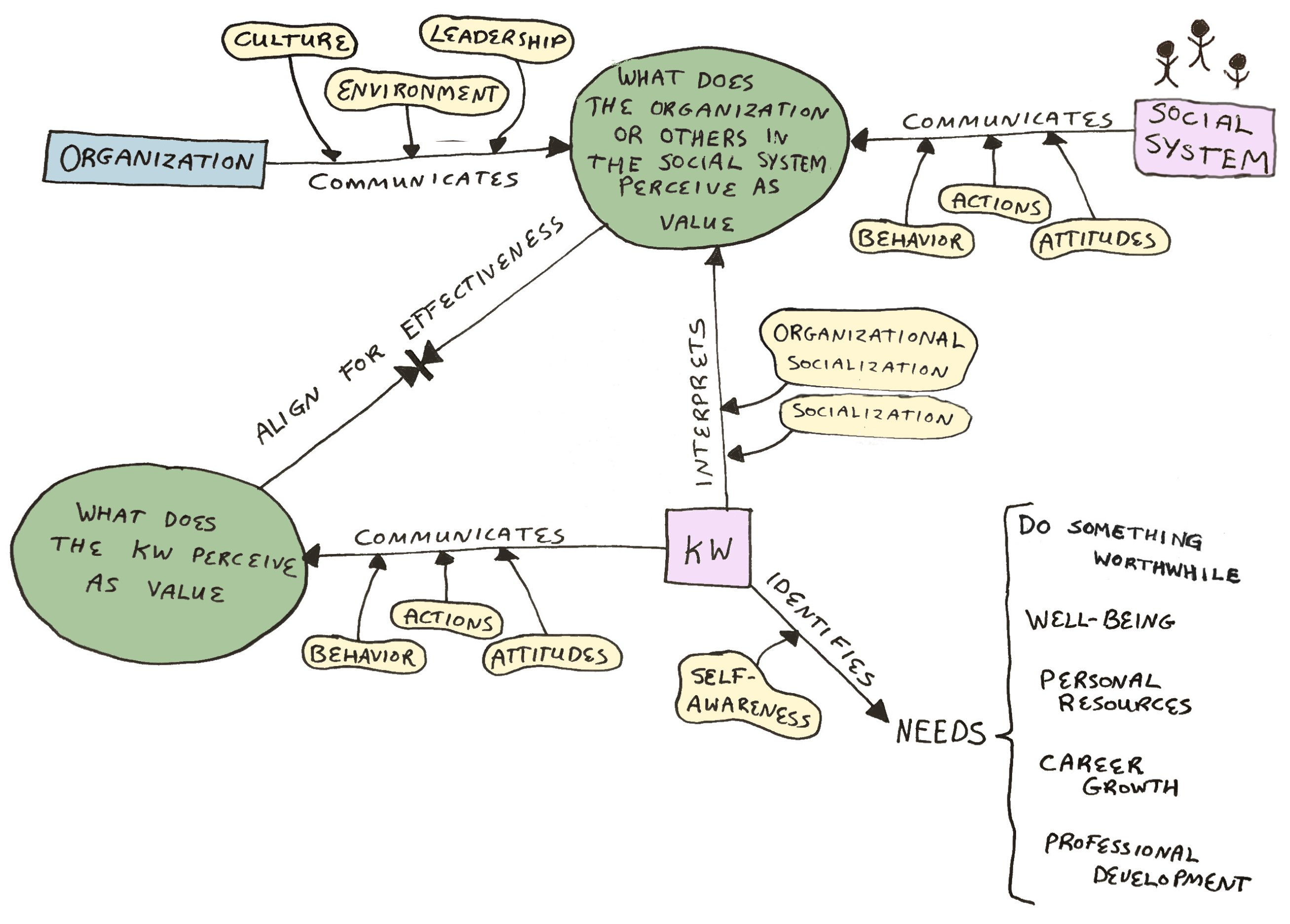


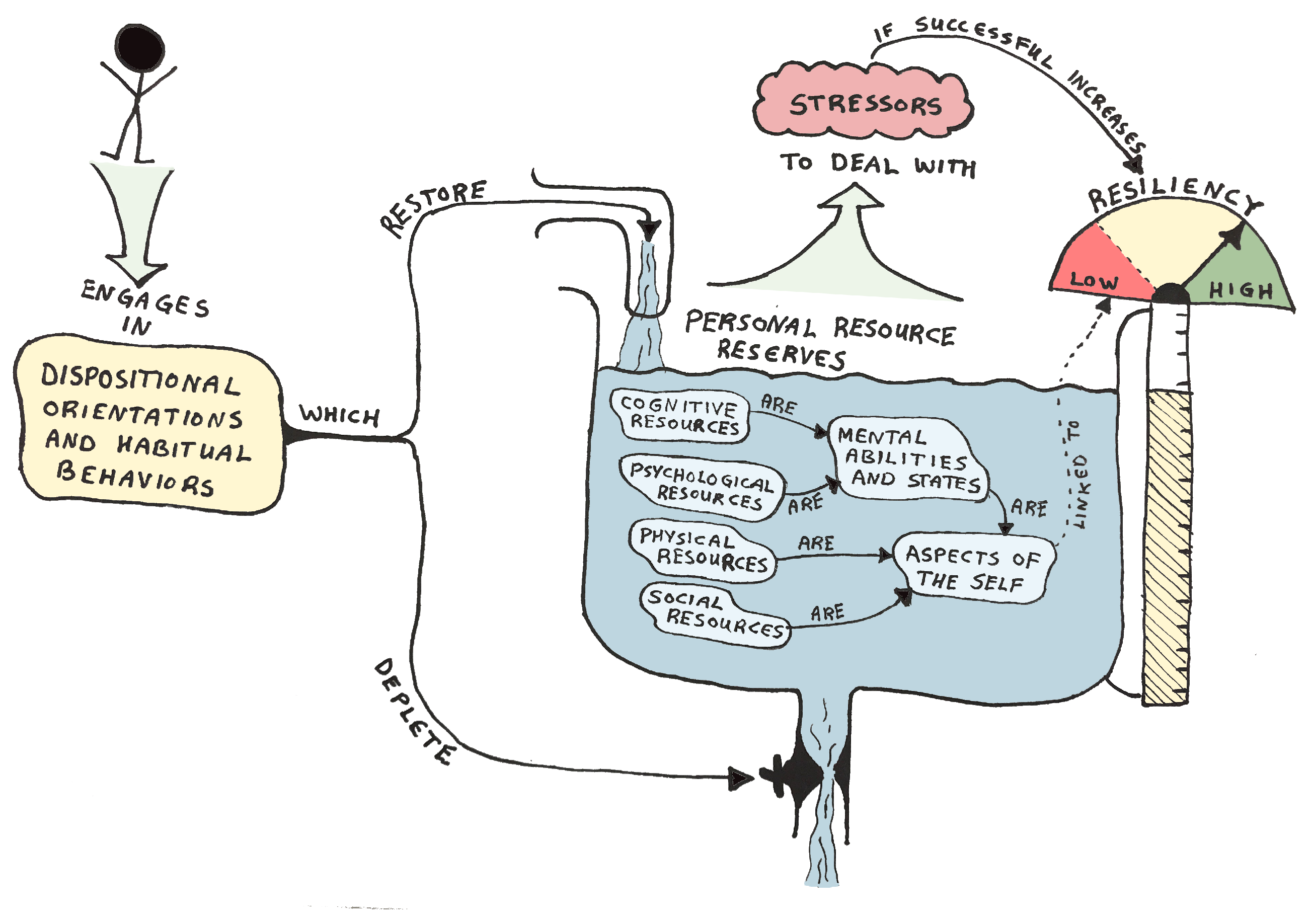
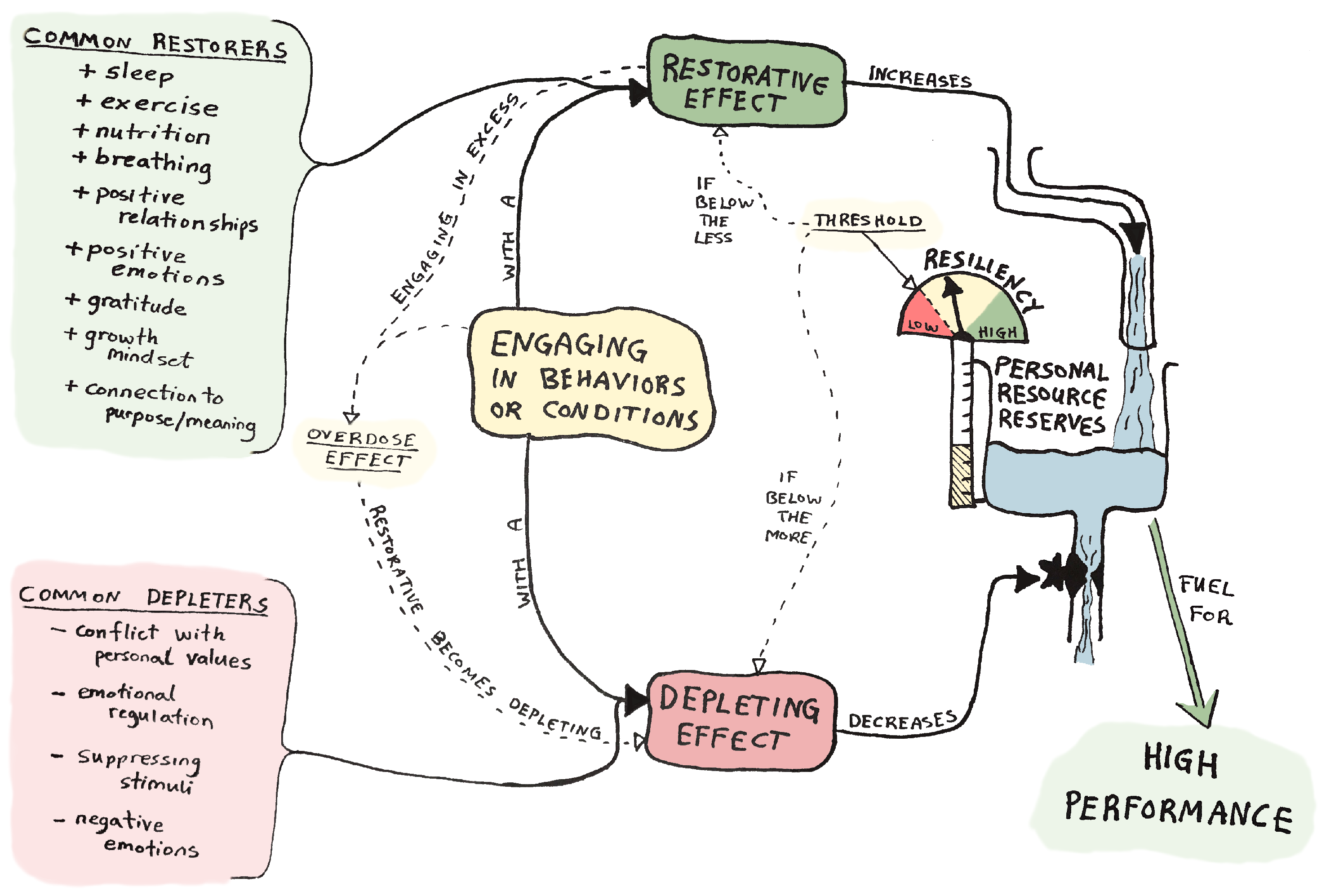
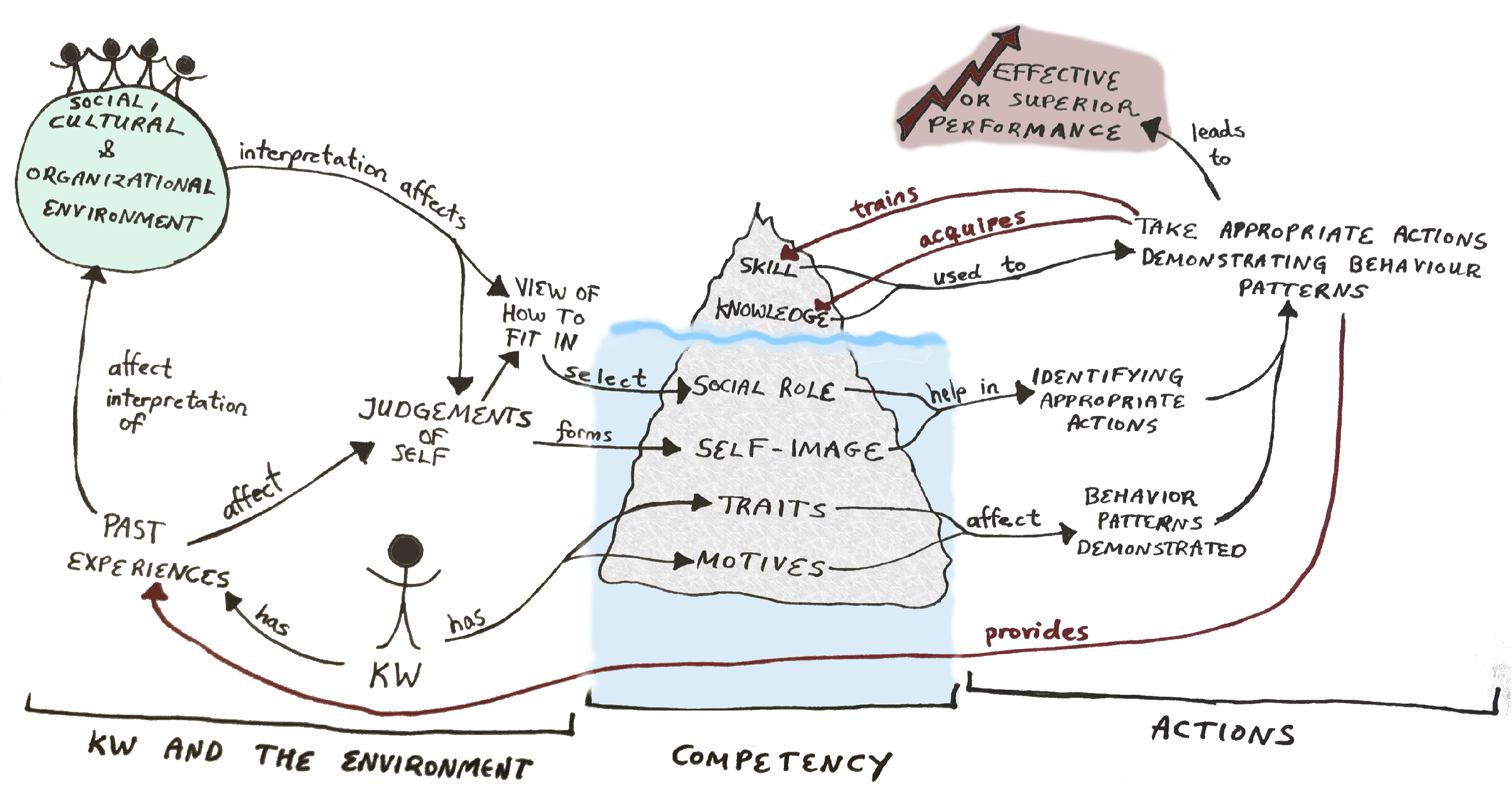


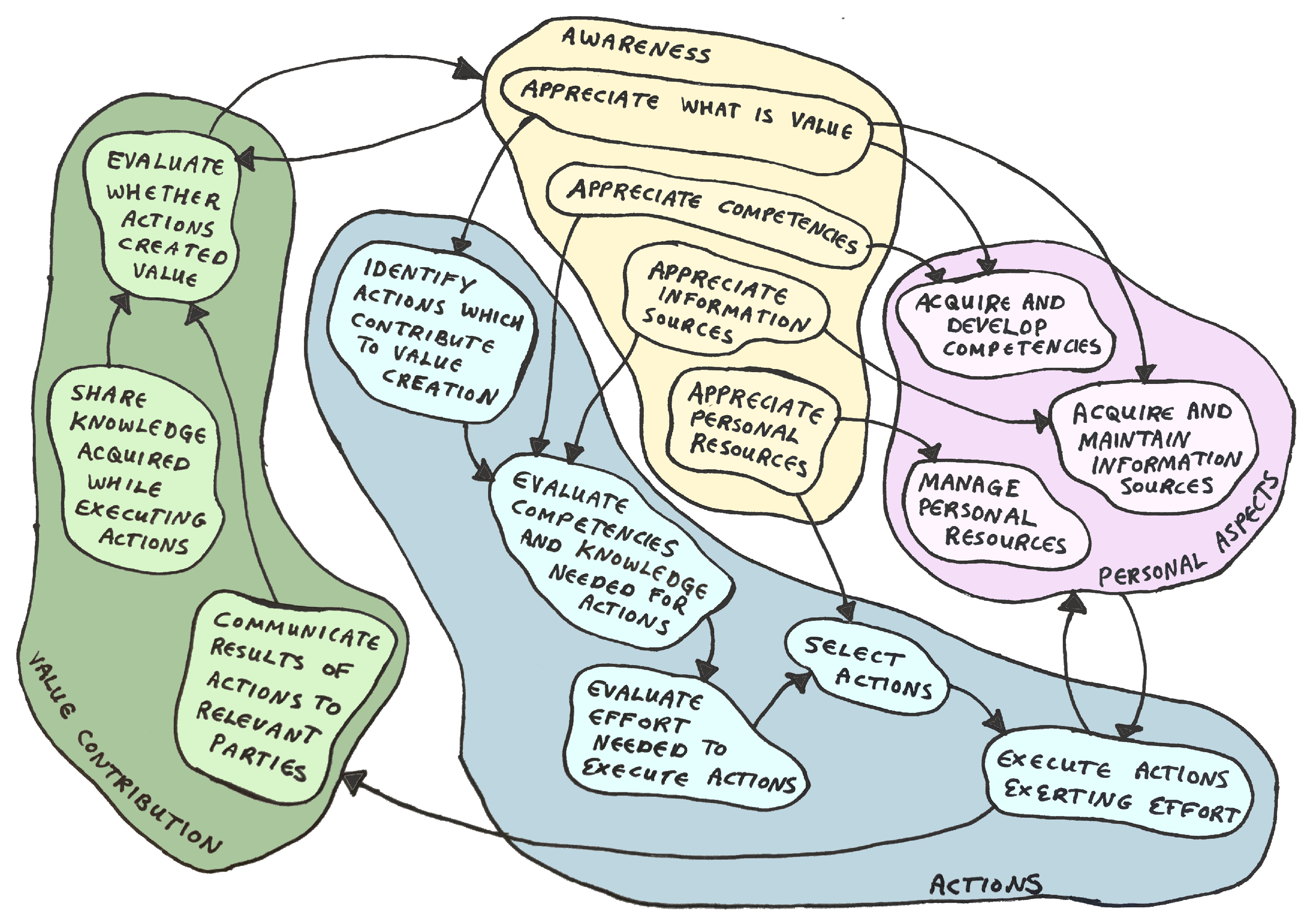
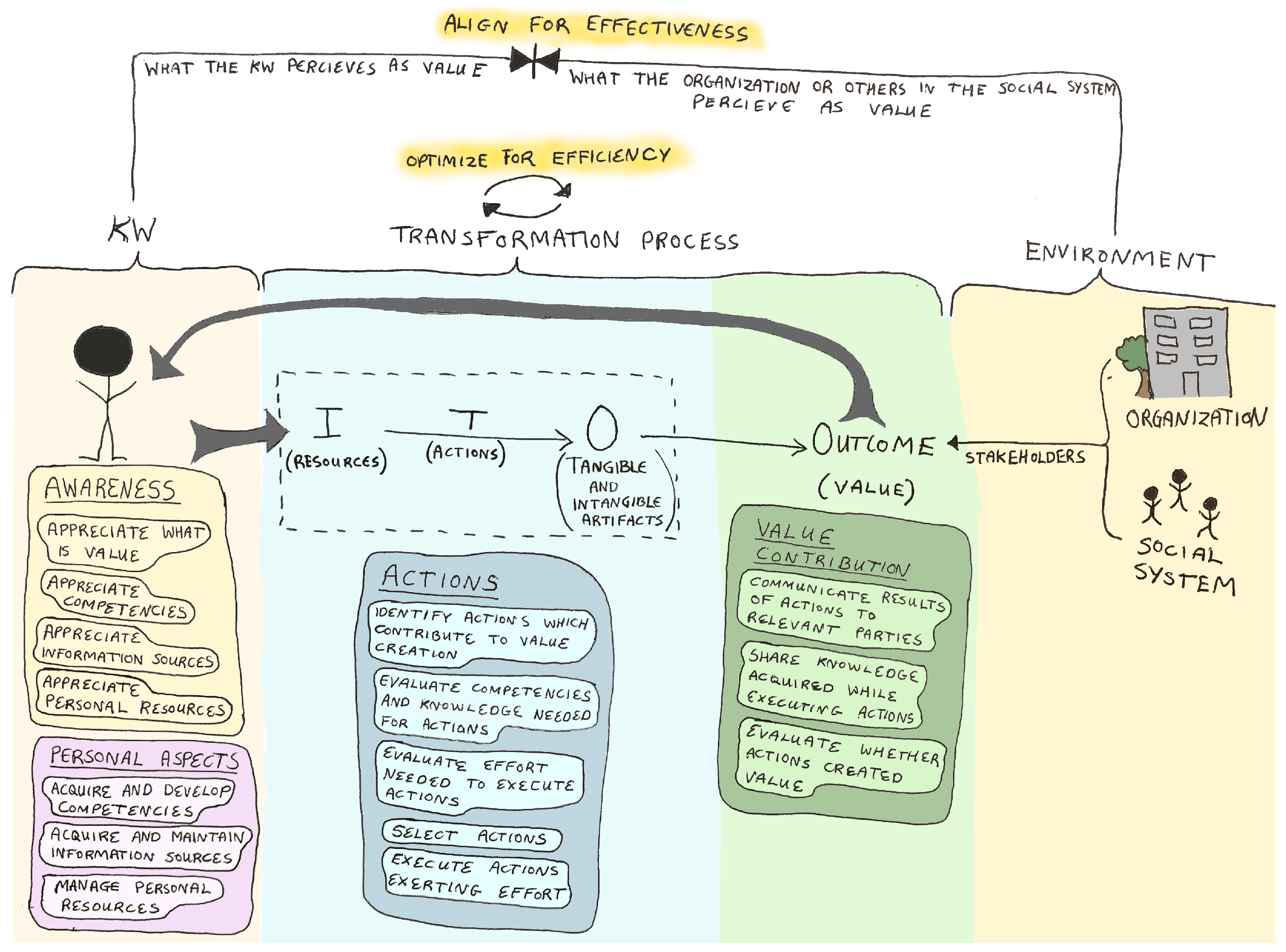
| Root Definition: |
|---|
| A system, owned by the individual KW, in which the KW uses resources to execute actions exerting effort to create tangible or intangible artifacts with the intention of creating value. |
| Key Takeaways |
|---|
| The KW might not create the value he/she intends if there is a mismatch between the KW’s interpretation and what others perceive as value. |
| - Organizations need to make sure the organizational culture, environment, and leadership |
| reflect what is value to the organization. |
| - KWs need to integrate successfully into the organization by observing, imitating, and |
| building relationships with successful and competent insiders. |
| The KW intrinsically gravitates towards actions that fulfill his/her own needs. |
| - Organizations need to design the actions, required to fulfill organizational objectives, |
| to fulfill the needs of KWs, as well and use incentives to align the value of the KW and the |
| organization. |
| - KWs need to use self-awareness to identify their needs and communicate them. |
| The KW’s personal resource levels affect how much effort is exerted when executing actions. |
| - Organizations need to give KWs the autonomy to manage the timing and sequencing of |
| their own work. |
| - KWs need to strategically sequence and time their sources of restoration to offset their |
| sources of depletion for high performance. |
| Focusing too heavily on efficiency improvements might create a bias for choosing actions that create known value immediately or require the least amount of effort. |
| - Organizations need to encourage and support innovative actions that might or might not |
| create value, to maintain their competitive advantage. |
| - KWs need to invest in self-development, by choosing actions that require new knowledge or |
| competencies, so that they can create more value down the road. |
| KW’s are interdependent, so value is often created by helping others, sharing knowledge, and delivering results in a timely manner so that others can use them to generate value. |
| - Organizations need to have a climate of supportiveness, belongingness, and mutual trust for |
| their KWs to be able to create a shared cognitive frame, as well as encourage knowledge |
| sharing and helping behaviors. |
| - KWs need to engage in helping behaviors, share their knowledge, and build relationships to |
| access information and knowledge. |
Publisher’s Note: MDPI stays neutral with regard to jurisdictional claims in published maps and institutional affiliations. |
© 2021 by the authors. Licensee MDPI, Basel, Switzerland. This article is an open access article distributed under the terms and conditions of the Creative Commons Attribution (CC BY) license (https://creativecommons.org/licenses/by/4.0/).
Share and Cite
Óskarsdóttir, H.G.; Oddsson, G.V.; Sturluson, J.Þ.; Sæmundsson, R.J. A Soft Systems Approach to Knowledge Worker Productivity: A Purposeful Activity Model for the Individual. Adm. Sci. 2021, 11, 110. https://doi.org/10.3390/admsci11040110
Óskarsdóttir HG, Oddsson GV, Sturluson JÞ, Sæmundsson RJ. A Soft Systems Approach to Knowledge Worker Productivity: A Purposeful Activity Model for the Individual. Administrative Sciences. 2021; 11(4):110. https://doi.org/10.3390/admsci11040110
Chicago/Turabian StyleÓskarsdóttir, Helga Guðrún, Guðmundur Valur Oddsson, Jón Þór Sturluson, and Rögnvaldur Jóhann Sæmundsson. 2021. "A Soft Systems Approach to Knowledge Worker Productivity: A Purposeful Activity Model for the Individual" Administrative Sciences 11, no. 4: 110. https://doi.org/10.3390/admsci11040110
APA StyleÓskarsdóttir, H. G., Oddsson, G. V., Sturluson, J. Þ., & Sæmundsson, R. J. (2021). A Soft Systems Approach to Knowledge Worker Productivity: A Purposeful Activity Model for the Individual. Administrative Sciences, 11(4), 110. https://doi.org/10.3390/admsci11040110





